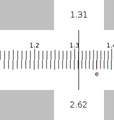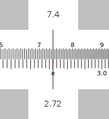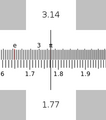Difference between revisions of "Activities/Sliderule"
(→Square) |
|||
| Line 48: | Line 48: | ||
=== Square root === | === Square root === | ||
| + | You also use the A and D slides to find the square root of a number. Simply position the reticule of number you want to square on the A slide and read the result off of the D slide. (Remember to properly estimate the proper decimal point for your result.) | ||
| + | |||
| + | √𝜋 = 1.77 | ||
| + | |||
| + | <gallery> | ||
| + | File:Sliderule-root-pi.png|Position the reticule over 𝜋 on the A slide and read the results (1.77) off of the D slide. | ||
| + | </gallery> | ||
=== Addition === | === Addition === | ||
=== Subtraction === | === Subtraction === | ||
Revision as of 10:32, 7 June 2010
How to use a slide rule
There are three parts to the slide rule: (1) a fixed rule (either the D scale or the L scale); (2) a sliding rule (the A, C, or L scales); and a reticule, which moves independently of the rules.
To move the sliding rules, simply drag them. Also to move the reticule, drag it. (Note: The entire slide rule does not fit on the screen. By dragging on the fixed rule, you can scroll the canvas to reveal different sections.)
Most calculations on a slide rule require three steps:
- position the end of the top slide above a number on the bottom slide;
- position the reticule over a number on the top slide;
- read the result from the bottom slide.
Note: You can read values from the fixed scale from either end of the sliding scale.
The Sliderule Activity displays these three values on tabs attached to the top slider and the reticule. The calculation is also displayed on the activity toolbar.
Note: The scales are all at a fixed scale. It is often necessary to move a decimal place in order to find the number you are looking for on the scale. It is up to the user to keep track and subsequently to estimate the decimal point in the final result.
Multiplication
To multiply, first position the end of the C slide over one of the multiplicands on the D slide. Then position the reticule over the other multiplicand on the C slide. Read the result off of the D slide.
Example: 2 × 1.31 = 2.62
Division
Division is the opposite of multiplication. First position the reticle over the divisor on the D slide. Then without moving the reticule, position the C slide so that the dividend is under the reticule. Read the result off of the D slide under the end of the C slide.
Example: 2.62 / 1.31 = 2
Square
You use the A and D slides to square number. (A is a log-log scale.) Simply position the reticule of number you want to square on the D slide and read the result off of the A slide. (Remember to properly estimate the proper decimal point for your result.)
e2 = 7.4
Square root
You also use the A and D slides to find the square root of a number. Simply position the reticule of number you want to square on the A slide and read the result off of the D slide. (Remember to properly estimate the proper decimal point for your result.)
√𝜋 = 1.77



